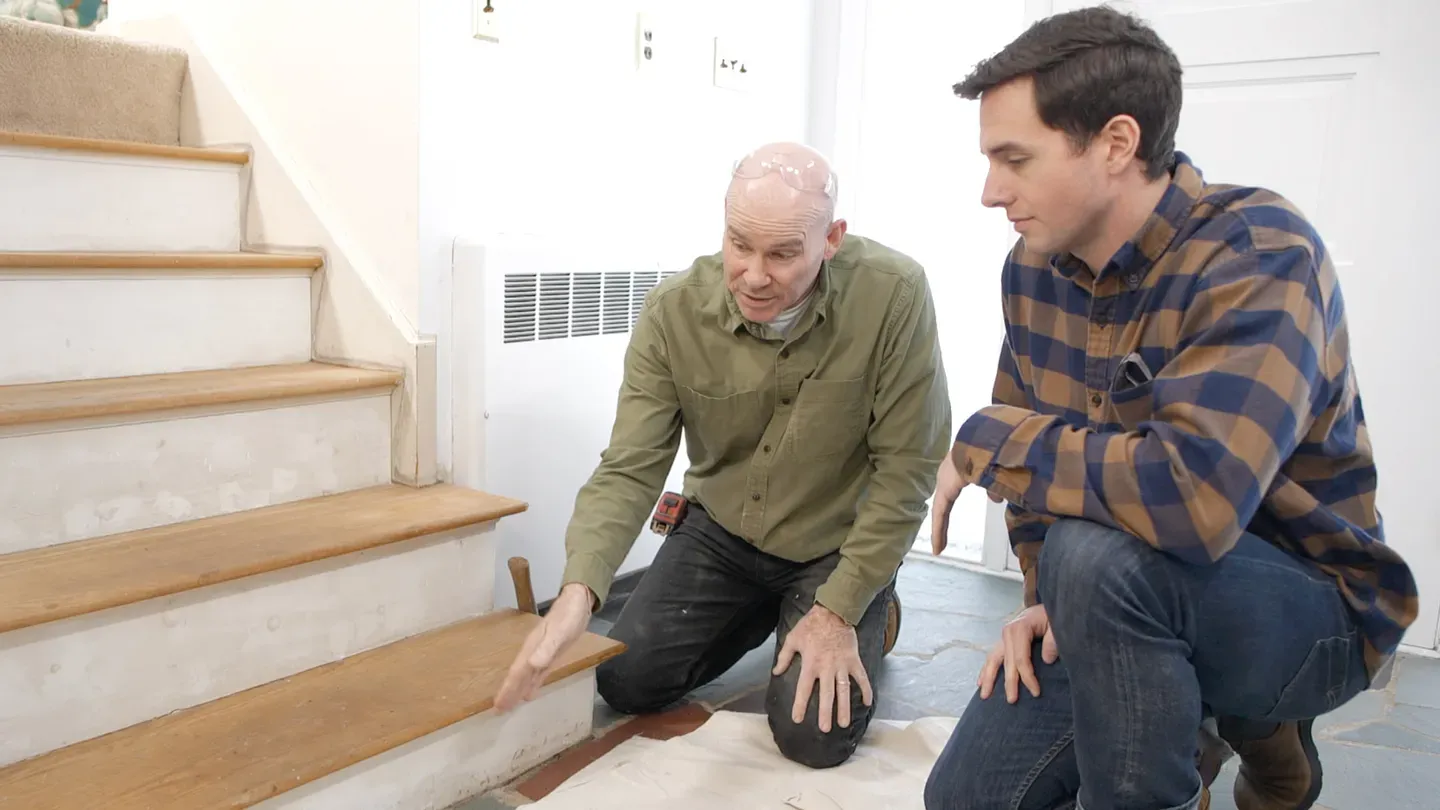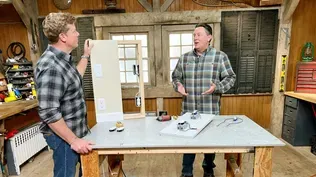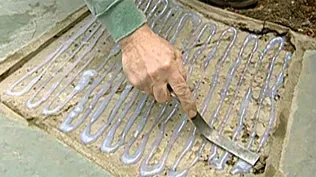

E23 | Flagstone Repairs, Tub Diverter | Ask This Old House
Season 21 Episode 23 | 23m 42sVideo has Closed Captions
Richard troubleshoots a leaky shower; Mark repairs flagstone steps.
Richard Trethewey troubleshoots why a homeowner's shower leaks when the tub is running and makes the necessary repairs, then in studio, Richard explains why it was a unique repair; Heath Eastman deep dives into different wire gauge sizes and the electrical load capabilities of each size; Mark McCulllough helps a homeowner repair some loose flagstone steps in his entryway and in his basement.
Problems with Closed Captions? Closed Captioning Feedback
Problems with Closed Captions? Closed Captioning Feedback
Funding for THIS OLD HOUSE is provided by The Home Depot and Renewal By Andersen.

E23 | Flagstone Repairs, Tub Diverter | Ask This Old House
Season 21 Episode 23 | 23m 42sVideo has Closed Captions
Richard Trethewey troubleshoots why a homeowner's shower leaks when the tub is running and makes the necessary repairs, then in studio, Richard explains why it was a unique repair; Heath Eastman deep dives into different wire gauge sizes and the electrical load capabilities of each size; Mark McCulllough helps a homeowner repair some loose flagstone steps in his entryway and in his basement.
Problems with Closed Captions? Closed Captioning Feedback
How to Watch Ask This Old House
Ask This Old House is available to stream on pbs.org and the free PBS App, available on iPhone, Apple TV, Android TV, Android smartphones, Amazon Fire TV, Amazon Fire Tablet, Roku, Samsung Smart TV, and Vizio.

This Old House Insider Newsletter
Get This Old House exclusive stories, tips, and behind-the-scenes information delivered right to your inbox every month.Providing Support for PBS.org
Learn Moreabout PBS online sponsorship♪♪ Kevin: On "Ask This Old House," our experts travel across the country to answer questions about your house.
♪♪ Today, when this tub spout is open, water pours out the shower head.
Richard will diagnose.
Next, Heath will explain how electrical circuits are designed.
And Mark is headed to New Hampshire to help a homeowner repair a loose flagstone in his entryway.
Mark: And eventually, everything ought to look the same.
John: Perfect.
Kevin: It's all coming up next on "Ask This Old House."
♪♪ Richard: Everett?
Everett: Richard.
Hey.
Richard: Nice to meet you.
Everett: You too.
Thank you so much for coming.
Roger: Glad to be here.
Everett: So, the problem I wrote about is with the bathtub upstairs.
Richard: Okay.
Lead on How long you guys been here?
Everett: It's been about three years now.
Richard: Alright.
Everett: And after we moved in, we took on this whole gut renovation in the bathroom.
Richard: You did it yourself?
Everett: We did.
Richard: Good.
Looks great.
Everett: Thanks.
And been happy.
But after all that, one problem arose, and that's now when I go to draw a bath, water starts coming out the shower head.
Richard: Okay.
Yeah, I've seen that before.
Let me in there.
Alright.
Well, that can be really annoying, can't it?
Everett: It is, and this is where we like to do bath time with my 8-month-old.
And so you can imagine it's especially annoying.
Richard: Alright, so what you got is a shower valve with a tub spout diverter.
Now, you sent me that video, so I knew what you had.
So what I did is I brought some demonstrators, some pieces to help understand what could be going wrong here.
Let me just run to the truck.
Everett: Okay.
Alright, Richard.
What do we have here?
Richard: Well, I thought we would take over your beautiful living room/study, and turn it into a little training classroom to help understand what's going on inside the wall.
So, for years, there was always a choice in what you put inside for a pressure-balanced shower valve.
It was either a shower valve or a tub-and-shower valve.
So typically it always would have a control valve right here.
And then when you turn it on, the water would default by coming out through the spout, down the bottom, or you would turn a diverter, and then it would positively drive the water up through the shower head.
And that was either gonna be a slide like this or a push button like this.
Everett: Yep, that's what the old shower head -- Richard: Okay, but the industry has moved away from this.
And so a basic shower valve is used for almost all the devices nowadays.
And so you've got the valve right here.
You got a hot and a cold line coming up into the shower valve.
And you turn it on.
And now the water, by design, you hope will fall down through here, and it comes through this spout.
And you'll see, in the default position, there's a hole that lets the water come out.
I've cut this apart so you can see it.
But as you lift it, you see what happens?
There's a guillotine that will close off right here.
And now when you do that, water pressure against it will hold it closed and then force the water this way.
And it actually goes through the valve and out through the shower head.
So some pretty interesting engineering inside here.
You see there's two holes?
Everett: Mm-hmm.
Richard: There's one hole that's larger.
Water would come through, through the larger hole, will fall down here.
You close that gate.
It forces its way back up through that smaller hole.
Well, look on the opposing side.
So now it's... [ Blows ] Allows water to pass right through the valve body.
So it's fundamentally really a "T." The water is just passing through it.
And it's been designed right into the valve body.
So the question is, why are you getting your symptom?
Well, there's only really two things that it could or should be.
One is some problem inside this guillotine mechanism that's causing a partial restriction that sends it back this way.
Or it could be that there's just too much water pressure trying to come down through this relatively small pipe, and it can't get through because there's so much pressure, and it forces it back this way.
So we got to do one diagnostic test, and we'll know what your problem is.
Alright.
So, diverted tub spouts are attached a couple of different ways.
One would be a set screw down here, which I know this manufacturer doesn't have.
The other is just that it's threaded onto the wall.
Okay.
So, now you can see right here, there's an O-ring right here with a thread.
Alright.
So now if we turn this on and water comes out here and we still have the same symptom, we know it's not downstream.
It's not in the diverter spout.
Okay?
So let's give that a test.
Hey.
Look what we discovered.
Everett: Huh.
Richard: Alright.
Look at this.
This is also telling me that is really high pressure.
We're just about shooting across the tub.
So what I'm going to do -- I'm going to go downstairs and I'm going to throttle down the supply valves up here.
Why don't you put that tub spout on carefully?
Everett: Okay.
Richard: We might be onto something here.
I'm gonna utilize the local isolation valves to the second-floor bath as balancing valves by closing the valves almost fully, and it should reduce the volume and the pressure to the shower valve.
If I adjust the water pressure correctly, the water should only come out of the tub spout when we turn the shower valve on.
Alright.
So down in the basement, I found the shut-off valves to this bathroom group -- the hot and the cold -- and I throttled them down so there should be less hot water pressure and cold water pressure to this valve.
And that means hopefully we'll have the right amount of water through that spout, so give it a try.
You always get the honors, the homeowners.
Tub spout has water.
And the shower head... Everett: Good Richard: ...doesn't.
Everett: So you're telling me this whole time it was just the water pressure?
Richard: Well, in your case it was the water pressure, but I was glad to be able to fix it for you, but also to teach people about some of the things that can and will go wrong with the tub spout diverter.
Alright?
I wish you the best.
Everett: Thank you very much.
Richard: I'll go clean up my little classroom down in the first floor.
I'll see you.
Everett: Alright.
See you later.
Kevin: Wow.
That was terrific.
I just learned a lot about spouts and valves and everything.
Richard: Water goes a lot of places.
Kevin: Although, I do have to say -- and don't take this the wrong way -- I found your solution maybe beneath you.
I was expecting something more complicated and elegant.
That was very simple.
Richard: Well, it turned out to be the only sort of affordable fix we could do for them, you know?
A lot of people would say, why don't you just put on a pressure-reducing valve, you know?
Because there was too much pressure.
Well, that wasn't the problem there.
There was no other place in this building where a little bit too much pressure was gonna come in the way.
If you had too much pressure on a toilet tank, it just would fill a little faster.
Kevin: Right.
Richard: But only in this place that we have this hole behind the valve -- if too much pressure comes in, it will not go down there, but it can also go up there.
Kevin: Yeah, I sense the fact that you do not like the change to this type of valve, that you are longing for the old days, which are what?
Richard: Right.
In the old days, every valve would have these -- these two shut-offs right here behind the plate.
So I could have throttled it here if I wanted to.
But more importantly, the original shower valves had this, which was a built-in diverter that said, instead of relying on that tub spout to drive the water up, you said, I want it to be from the spout or out of the shower head.
And it's like a set of gates on a train track.
The train either goes this way or this way.
So I did this little demo right here.
This represents where the shower valve is.
There's a shower arm.
So here's the tub spout right here.
But the tub spout diverters that have the diverter here instead of up in the valve can have some restriction either at the gate or at the connection itself.
And there's a little bit of a restriction there.
It might be subtle.
But if you now close the -- As if you're making this aperture just slightly a bit smaller like this.
So now the water goes the wrong way.
So you see how it's going back up through the valve, that little tiny hole.
And really that's the condition that our homeowner had.
So what we did is, we throttled it back -- was fundamentally the same as doing this.
Kevin: That's not, in your mind, a temporary fix.
We can have those shut-offs closed a little bit.
Richard: It's not perfect.
In an ideal world, we would have been able to go in and put the right valve in that would have these shut-off valves or this one right here.
But this at least gave him the chance to have the valve that won't drive him crazy as long as somebody doesn't change the settings.
Kevin: Yeah, cool.
Alright.
Well, very good.
Richard: Alright.
Kevin: I learned a ton.
♪♪ Hey, Heath.
Heath: Hey, Kevin.
Kevin: Wow.
The professor is in.
Look at your display here.
Heath: Yeah, I figured it was about time to have a little lesson on wire size, or the American wire gauge that we see a lot.
Kevin: "American wire gauge."
That's what that stands for?
Heath: AWG.
Yeah.
Kevin: That's funny.
I always thought it was just "awg."
Okay.
Heath: So you can see we have a lot of different sizes, and there's a lot of different reasons for having these.
It depends on what a device is going to utilize as to how big the wire is going to be.
How much power it needs.
Kevin: Right.
So not all "electricity" is the same when it's running through our house?
Heath: Right.
We can't just run one size wire to feed everything in there.
Kevin: Okay.
Heath: So it starts off with these smaller numbers, and it actually runs backwards till it gets to a certain point down here, and then it starts climbing again.
Kevin: So let's start with the smallest.
Heath: So this is 18 gauge.
And in this case, it's a thermostat wire.
And we have four conductors, but each conductor is 18 gauge.
So that one right there is 18.
Kevin: Okay.
So something like that, used for thermostats, doesn't require a lot of power.
Heath: Right.
Kevin: Sufficient.
Heath: Control.
Kevin: Alright.
Moving up from there?
Heath: So, next step is 14.
Kevin: Mm-hmm.
Heath: This we'll see a lot in the house.
And the color kind of helps us identify it in newer homes.
This we're gonna see for loads like lighting, bedroom receptacles, that kind of thing.
Kevin: Basic, predictable.
Heath: Right.
Kevin: No problem.
Heath: Yeah.
And you can see it's a little bit bigger than that 18.
Kevin: I have heard you throw around 14/2, 14/3.
That refers to what?
Heath: So, that refers to the number of conductors.
So the first number is the gauge size, that 14 that we can see.
But then the 2 would be we have two conductors and a ground.
So one, two, and our ground.
That's our 14/2.
Kevin: And so there might be a third conductor if you have that three-way switch or something like that?
Heath: Exactly.
Kevin: But it's still the same size.
Heath: Same size.
Just more conductors in the jacket.
Kevin: Okay.
I'm also familiar with this.
You seem like we always run that in the kitchen and other places.
Heath: Kitchens.
Your washing machines.
Sometimes in the basement.
Bathrooms.
We want that larger size, that 12 gauge, that can handle 20 amps.
Kevin: Because we're gonna be using appliances that pull more electricity, a dishwasher, a blender.
Heath: Exactly.
So those are the areas we're going to have coffee makers, toasters in the kitchen.
Needs a lot more power.
Want to have a larger cable that can handle that.
Kevin: Mm-hmm.
We've talked about GFCI receptacles before.
They always are attached to something like this.
Just out of curiosity, do we ever put a GFCI protection on this?
Heath: You can if it's providing power for something in the garage, in the basement, absolutely.
There's no problem putting a GFCI on that.
Kevin: Cool.
Okay.
So moving on to the orange.
Heath: The orange.
10 gauge.
30 amps.
Typically in a residence -- dryers, maybe your outdoor air-conditioning unit, maybe a small oven in the kitchen.
Kevin: Stuff that you know is gonna pull a lot of electricity.
Heath: That's going to draw a lot more.
Correct.
Kevin: So let me just ask you.
What if I start using the wrong wires or what if I start trying to plug things in to maybe the 14 gauge that I shouldn't?
Heath: That you shouldn't.
Kevin: Yeah.
Heath: So, what's going to happen is certain appliances use a certain amount of power, so if something's really designed to be used in a kitchen or a bathroom, you want to try and plug it in there.
If you try and plug it into a bedroom circuit that's a little bit smaller, it may draw too much current.
It may overheat the wire.
It may draw too much for the breaker and cause a trip.
We don't want to have an overheating issue where we're plugging something into the wrong place.
Kevin: So don't bring the blender into the bedroom?
Heath: Please don't bring the blender into the bedroom.
Kevin: [ Laughs ] Okay.
This guy here?
Heath: So that's our 8.
We're going to see this maybe for some smaller ovens, air-conditioning units, that kind of thing, as well.
Kevin: Right.
And then 6s?
Heath: This might be one of the last ones you'll typically see in the basement of your house if you're looking around or if you open up some of the walls.
We're going to use this for an electric oven, maybe a Level 2 car charger.
Kevin: Gotcha.
So that means that from this point on, this is sort of more big-boy stuff here?
Heath: Right.
Now we get into the single conductors, and this is where we're going to install these typically in a conduit, use it for a larger load.
Maybe we're feeding a hot tub outside.
Maybe we're feeding a subpanel in the house.
That's where these are going to come in.
Kevin: So that's interesting.
You call them single conductors.
So, at first glance, this looks a lot bigger than this.
Heath: Right.
Kevin: But to your point, there is only one of these copper conductors.
So we're comparing that... Heath: To this.
Kevin: ...just to one of those.
Heath: Correct.
So this is a jacket with multiple conductors.
This is just our single.
Kevin: Okay.
So when do we use things like this -- or this?!
Heath: So this -- this is something much larger.
So, something like this or even this, this is 500 KCMIL.
This is the size.
So if you really want to confuse the numbers, we go backwards till we hit 1/0, start going up, and then we go metric.
KC -- Oh, the letter "KC..." Heath: 1,000 circular millimeters.
Kevin: Gotcha.
Heath: So this would actually carry 400 amps.
Kevin: And so why would I use that?
Heath: If you had a really large residential service.
I mean, it's a little unusual.
More of a commercial or industrial application.
Kevin: Right.
Heath: For a 200-amp service in a home, though, if we're doing copper versus aluminum, we're gonna use this -- 3/0.
Kevin: Gotcha.
So headline here -- Right wire for the right usage for the right appliance or circuit or something like that.
Heath: And you'll be good.
Kevin: Alright.
Well, next time we're gonna talk about volts and amps, but this is enough for now, Professor.
Heath: Sounds good.
Kevin: Thank you.
♪♪ John: Hi, Mark.
Mark: Hey, John.
How you doing?
John: Good.
How are you?
Mark: Alright.
I'm doing great.
So this is the flagstone.
John: Yeah, this is the flagstone we wrote you about.
Mark: Yeah, I love it.
I love it.
This looks like you did a lot of cleaning to it.
John: Yeah, definitely.
It's been a lot of work.
We stripped a lot of shellac, or urethane from the floor.
This is what it looked like when we first moved in.
Mark: Oh, wow.
John: You can see the haze.
Mark: Oh, holy mackerel.
Yeah.
Wow.
So how'd you take that off?
John: We used a paint stripper and a lot of elbow grease.
Mark: Oh, a lot of elbow grease.
I can tell.
And it looks like you've done work around the entire space?
John: Yeah, we've stripped the wallpaper off the walls and pulled up some carpet, hoping to just really refinish the steps and everything.
Mark: Okay, and you wrote me about a couple specific things to do with the flagstone, correct?
John: Yep.
When we pulled that carpet up, we noticed that that joint was in a state of disrepair.
Mark: Okay.
John: And then we've got another stone over here I wanted you to take a look at.
Mark: Alright.
Yeah, Look at that.
John: It's got a good rock to it when you step on it.
Mark: Yeah.
Oh, I can see that.
Yeah.
So this is a safety thing.
Oh, yeah.
Look at that.
Wiggly.
So, I can see you use some shims here, some plastic shims to keep it somewhat level.
Yeah.
So this is a safety hazard.
Definitely something that we should repair.
So why don't we get some tools and get going?
John: Awesome.
Sounds great.
Mark: Alright, John.
Alright, so, the first thing we want to do is loosen up these stones.
And the way I'm gonna do that is I'm gonna alleviate the tension by breaking this joint of cement all the way across the doorway.
John: Okay.
Mark: Alright?
And I'm gonna start with a cold chisel.
There you go.
Alright.
So, John, why don't you just get that chisel under that stone and just see if we can pry it up?
Oh, yeah.
Okay.
That wanted to come right away.
Alright.
So take that.
Now I'm gonna do the same thing here.
So, what I'm trying to do, John, is crush this joint instead of pulling it up.
John: Yep.
Mark: See if you can get under that stone, John.
Just pry it up.
There we go.
Previous homeowner stuck some silicone under there as glue.
That's what held this up a little.
Peel that right back.
Yeah.
Alright.
Let's see if you can get under that bed of mortar right there.
So let's get everything swept up.
♪♪ Alright, John.
Now it's time to mix the mortar.
We have a couple different choices with our mortar.
We could use a type N, but I like to use that outside with brickwork.
There's a little bit more flexibility in the type N. The type S, which is what is in front of you -- I tell everybody all the time when you hear type S, it means strength.
So in a doorway just like this and nailing down these flagstone, I think we want to stay strong.
So that's why I'm with the type S. John: Great.
Mark: We used to have to get sand, lime, portland, mix them all together, but now they make it very easy.
You can go into your big-box hardware store and just get a pre-mixed bag, and all we have to do is add water.
John: That's convenient.
Mark: Gingerly start to turn it over.
We're inside, so we want to cause very little dust.
The easier you go, the less dust there will be.
Alright.
So this is looking pretty good.
But before we lay down our mortar bed, we want to add a bonding agent.
You can apply the bonding agent to the mortar directly or what I like to do is get a paintbrush and paint it on.
That way, I get all the nooks and crannies.
Make sure we get everything.
You can't use too much.
We can use it whether it's dry or wet.
We can put our mortar on top of it.
So... John: Great.
Mark: What they didn't do the first time here was they didn't pre-wet the cement block.
John: Yep.
John: What that did was suck out all of the water out of the mix and made the mix very brittle, so that was the start of the problems that you had with those two flagstone.
John: Okay.
Mark: Now I'm gonna get ready for the bed.
All we're looking to do is level this out.
We're actually gonna leave it a little higher than the stone needs to be.
I'm gonna really try to jam it into this stone and under the stone.
Now, this mortar that we're using right now is a little stiff.
But when you're doing any type of stonework, a flagstone or just a regular stone, the material is usually a lot heavier.
So the stiffer the mortar, the more strength it has to kind of prop it up as you're working it into place.
John: So.
Yeah.
Perfect.
Mark: So, your mark is going to be just the edge... John: Yep.
Mark: ...of the stone.
And I like to wiggle down into place.
Alright.
We're just gonna shake it down.
Okay.
You can just imagine the bond that I'm making on the bottom of the stone as I wiggle.
John: Yep.
Mark: Just wiggle that into place.
Alright.
Right in there, John.
Alright.
So you see the voids.
All we want to make sure is we don't have any.
Be mindful of the stone, that it's still floating a bit.
I'm gonna come on top here for this joint here.
I'm gonna use the sponge for a couple different things.
I'm gonna clean the edges of the stone, just like you see me doing here.
John: Mm-hmm.
Mark: But most importantly, what I'm gonna do is rub this sponge over that joint.
And you see the sand that I'm picking up?
Jenn: Yep.
Mark: Okay.
That sand, we call it the aggregate.
All that sand is gonna be pulled up to the top.
And it's gonna mimic the existing joint.
And eventually everything ought to look the same.
John: Perfect.
Mark: We'll have to do this a few times.
There we go.
John, why don't you give me that edge right there?
Yep.
So I love all this.
You see that right there?
All of that sand.
Once this dries, it's gonna look like the rest of the floor, and you won't even know we were here.
John: That's great.
Mark: So let's let this set up a little bit, and then we'll have to hit it one or two more times.
John: Great.
Mark: Alright.
So, John, believe it or not, this is a very common problem.
Every time you bring masonry into something that's wood, there's always a break.
A little extra going on here is this wood has actually sucked the water out of the material.
John: Interesting.
Mark: Yeah.
It makes it weak and brittle, and that's why this will break up.
So all we need to do is break this joint up, clean it out a little bit, and we're gonna replace it with what we call a soft joint, which is just caulking.
John: Cool.
♪♪ ♪♪ Just peeling it out with my fingers now.
♪♪ I want to put an edge tape down here.
John: Okay.
Mark: What it's going to allow us to do is let that caulking set up after we put it in.
♪♪ ♪♪ I'm gonna use a little trick that I learned years ago to help me smooth this caulking.
And it's just using a little dish soap.
♪♪ ♪♪ Alright, John.
What do you think?
John: It looks beautiful.
Mark: Alright.
Mark: Well, I'm happy with it, as well.
So all I ask is that you wait 28 days for this to cure.
This is a perfect temperature for curing, so we're gonna be good.
You can see that we're a little dark right now.
That's only because we're wet.
But once that starts to dry out, you'll see that it matches the floor just great.
And over here, the caulking joint -- pretty much the same thing, right?
The goal was just to roll it up a little bit.
So when you paint that riser white, everything blends in seamlessly.
And I think we achieved that.
So, happy with that, as well.
And then the last little bit of homework that you have is this masonry sealer.
It's actually a luster.
So it'll make sure that the entire floor, the stone and the joints, brighten up a little bit and have a shine to them.
And that's also going to help us take this patch into the room and, again, make everything look seamless.
John: Perfect.
Mark: Alright.
Great.
So thanks for having me, John.
John: Thanks, Mark.
Mark: Glad everything went well.
I'll see you soon.
John: Really appreciate it.
Mark: Yeah, you got it.
Kevin: Next time on "Ask This Old House"... Tom is put to the test with a project a little outside his comfort zone.
Tom: [ Inhales sharply ] I love a good challenge.
Kevin: He'll brainstorm the best way to replicate an original 1900s hand-carved stair baluster... ♪♪ ...then restoring the finished creation to the original railing.
Tom: Alright.
There you go.
Kevin: That's next time on "Ask This Old House."
Support for PBS provided by:
Funding for THIS OLD HOUSE is provided by The Home Depot and Renewal By Andersen.

















